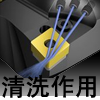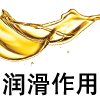Process lubricants used in the cutting, forming, processing, and protection processes of metals and their alloys are collectively referred to as metalworking fluids, also known as cutting fluids. In the metal processing process, in order to reduce the cutting force during cutting, and timely take away the heat generated in the cutting zone to reduce the cutting temperature, improve the tool durability, thereby improving production efficiency, improving the surface roughness of the workpiece, and ensuring the machining accuracy of the workpiece, For best economic results, metalworking fluids are often used.
Proper use of cutting fluid during cutting can reduce the friction between the tool and the chip, the tool and the machined surface, reduce the cutting force and cutting temperature, reduce tool wear and improve the quality of the machined surface.
The cutting fluid enters the cutting zone, which improves the cutting conditions and improves the machining quality and cutting efficiency of the workpiece. Similar to cutting fluids are certain gases and solids such as compressed air, aluminum disulfide and graphite. The main functions of the cutting fluid are as follows:
The cutting fluid can remove a large amount of cutting heat from the cutting area, thereby reducing the cutting temperature. Cooling performance depends on its thermal conductivity, specific heat capacity, heat of vaporization, vaporization rate, flow rate, flow rate, and the like. The aqueous solution has the best cooling performance and the cutting oil is poor, as shown in the table below.
Water and oil performance comparison

Lubricity of the cutting fluid means that it reduces the friction between the rake face and the chip, the flank and the surface of the workpiece. The lubricating effect of the cutting fluid is achieved by the penetration of the cutting fluid into the cutting zone, and the adsorption film is formed at the interface of the tool, the workpiece and the chip. The effect of the cutting fluid lubrication depends mainly on the penetration ability of the cutting fluid, the ability to adsorb the film, and the strength of the lubricating film.
The friction between the two metal surfaces usually has three states: one is dry friction, which occurs only between the two surfaces that are absolutely clean; the second is fluid lubrication friction, which completely separates the two friction surfaces by the oil film. The third is the boundary friction between the first two, that is, the two friction surfaces are not completely separated by the oil film, but directly rubbed at the partial convex points. In the metal cutting process, the friction between the tool rake face and the chip, the flank face and the machined surface is mostly boundary lubrication friction.

When fine chips or abrasive powders are produced during cutting, the cutting fluid is required to have good cleaning performance to remove adhering debris and grinding powder, reduce the wear of the tool and the grinding wheel, and prevent the surface of the workpiece from being scratched and the machine guide surface. . The large flow of cutting fluid can wash away the finely divided chips and falling abrasive grains in the cutting area and machine tool.
The cleaning performance depends mainly on the fluidity, permeability, service pressure and oiliness of the cutting fluid. Adding a large amount of surfactant and a small amount of mineral oil, and using a large dilution ratio (95% to 98% water), can enhance the permeability and fluidity of the cutting fluid.
The cutting fluid should have a certain rust resistance to reduce corrosion of workpieces, machine tools and tools. The effect of rust prevention depends on the properties of the cutting fluid itself and the nature of the rust inhibitor added. Adding a rust inhibitor to the cutting fluid can form a protective film on the metal surface, which can prevent rust on workpieces, machine tools, tools and fixtures.
In addition to the above effects, the cutting fluid should also have good stability, have certain resistance to bacteria and mold, do not damage the painted parts, no harm to the human body, no irritating odor, no smoke or less smoke during use, easy Recycling, low pollution, after treatment can reach the national industrial wastewater discharge standards.
Aluminum Screw Machined Parts
Aluminum Screw Machined Parts,Custom Cnc Aluminum Screw Machined Parts,Aluminum Machined Parts,Machined Aluminium Parts
Stand Dragon Industrial Co., Ltd. , https://www.standdragontw.com





